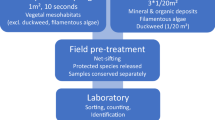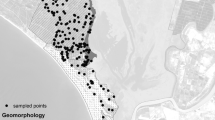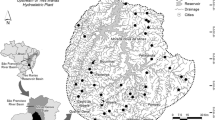Abstract
Despite a recent surge of interest in temporary lentic systems, a strong theory linking the biota to its environment has not emerged. Using data from 10 temporary ponds at Mammoth Cave National Park, Kentucky, USA, we investigated how invertebrate communities were structured along environmental gradients, both between and within ponds. Samples were collected with a benthic corer in winter and spring, and a sweep net in spring. Six between-pond and two within-pond datasets were created. Between-pond analyses yielded significant CCA’s with only one of the six data sets. The ranges of environmental variables (EV’s) within ponds were often similar to the ranges of EV’s when averaged and compared between ponds. Some taxa were aggregated in a single pond, and richness increased with pond area. The theory that richness increases with hydroperiod did not apply to these systems. Within-pond analyses yielded more consistent relationships, with both CCA’s being significant. Sample depth was the best predictor of invertebrate richness and abundance, with most taxa preferring shallow habitats. Richness and abundance were higher in both shallow ponds and shallow areas of deep ponds than in deep areas of deep ponds. Standardizing sample depth may be an effective way to remove this gradient as a confounding variable in future research. The presence of within-pond gradients, possibly coupled with the limited dispersal and random colonization of tolerant taxa, makes between-pond comparisons difficult.


Similar content being viewed by others
References
Barbour, M. T., J. Gerritsen, B. D. Snyder & J. B. Stribling, 1999. Rapid Bioassessment Protocols for Use in Streams and Wadeable Rivers: Periphyton, Benthic Macroinvertebrates and Fish. EPA 841-B-99-002. U.S. Environmental Protection Agency; Office of Water, Washington, D.C.
Battle, J. & S. W. Golladay, 2001. Water quality and macroinvertebrate assemblages in three types of seasonally inundated limesink wetlands in southwest Georgia. Journal of Freshwater Ecology 18: 189–207.
Batzer, D. P. & K. A. Sion, 1999. Autumnal woodland ponds of western New York. In Batzer, D. P., R. B. Rader & S. A. Wissinger (eds), Invertebrates in Freshwater Wetlands of North America: Ecology and Management. John Wiley and Sons, New York: 319–332.
Batzer, D. P., R. B. Rader & S. A. Wissinger, 1999. Invertebrates in Freshwater Wetlands of North America: Ecology and Management. John Wiley and Sons, New York.
Batzer, D. P., B. J. Palik & R. Buech, 2004. Relationships between environmental characteristics and macroinvertebrate communities in seasonal woodland ponds of Minnesota. Journal of the North American Benthological Society 23: 50–68.
Batzer, D. P., S. E. Dietz-Brantley, B. E. Taylor & S. E. DeBiase, 2005. Evaluating regional differences in macroinvertebrate communities from forested depressional wetlands across eastern and central North America. Journal of the North American Benthological Society 24: 403–414.
Beisel, J. N., P. Usseglio-Polatera, V. Bachmann & J. C. Moreteau, 2003. A comparative analysis of evenness index sensitivity. International Review of Hydrobiology 88: 3–15.
Bonner, L. A., W. J. Diehl & R. Altig, 1997. Physical, chemical and biological dynamics of five temporary dystrophic forest pools in central Mississippi. Hydrobiologia 353: 77–89.
Brooks, R. T., 2000. Annual and seasonal variation and the effects of hydroperiod on benthic macroinvertebrates of seasonal forest (“vernal”) ponds in central Massachusetts, USA. Wetlands 20: 707–715.
Brose, U., 2003. Island biogeography of temporary wetland carabid beetle communities. Journal of Biogeography 30: 879–888.
Cowardin, L. M., V. Carter, F. C. Golet & E. T. LaRoe, 1979. Classification of Wetlands and Deepwater Habitats of the United States. U.S. Fish and Wildlife Service, Washington DC, USA FWS/OBS-79/31.
Dahl, T. E., 1990. Wetlands Losses in the United States 1780’s to 1980’s. U.S. Department of the Interior, Fish and Wildlife Service, Washington, D.C: 13 pp.
Della Bella, V., M. Bazzanti & F. Chiarotti, 2005. Macroinvertebrate diversity and conservation status of Mediterranean ponds in Italy: water permanence and mesohabitat influence. Aquatic Conservation: Marine and Freshwater Ecosystems 15: 583–600.
Epler, J. H., 2001. Identification Manual for the Larval Chironomidae (Diptera) of North and South Carolina. North Carolina Department of Environment and Natural Resources Special Publication SJ2001–SP13, Raleigh, NC.
Euliss, N. H. & D. M. Mushet, 1999. Influence of agriculture on aquatic invertebrate communities of temporary wetlands in the prairie pothole region of North Dakota, USA. Wetlands 19: 578–583.
Fairchild, G. W., J. Cruz, A. M. Faulds, A. E. Z. Short & J. F. Matta, 2003. Microhabitat and landscape influences on aquatic beetle assemblages in a cluster of temporary and permanent ponds. Journal of the North American Benthological Society 22: 224–240.
Gabor, T. A., H. R. Murkin, M. P. Stainton, J. A. Boughen & R. D. Titman, 1994. Nutrient additions to wetlands in the Interlake region of Manitoba, Canada: effects of a single pulse addition in spring. Hydrobiologia 280: 497–510.
Gorham, C. T. & D. S. Vodopich, 1992. Effects of acidic pH on predation rates and survivorship of damselfly nymphs. Hydrobiologia 242: 51–62.
Haack, S. K., G. R. Best & T. L. Crisman, 1989. Aquatic macroinvertebrate communities in a forested wetland: interrelationships with environmental gradien. Freshwater Wetlands and Wildlife 61: 437–454.
Harmon, M. E., J. F. Franklin, F. J. Swanson, P. Sollins, S. V. Gregory, J. D. Lattin, N. H. Anderson, S. P. Cline, N. G. Aumen, J. R. Sedell, G. W. Lienkaemper, K. J. Cromack & K. W. Cummins, 1986. Ecology of coarse woody debris in temperate ecosystems. Advances in Ecological Research 15: 133–302.
Higgins, M. J. & R. W. Merritt, 1999. Temporary woodland ponds in Michigan: invertebrate seasonal patterns and trophic relationships. In Batzer, D. P., R. B. Rader & S. A. Wissinger (eds), Invertebrates in Freshwater Wetlands of North America: Ecology and Management. John Wiley and Sons, New York: 279–297.
Hurlbert, S. H., 1971. The nonconcept of species diversity: a critique and alternative parameters. Ecology 52: 577–586.
MacArthur, R. H. & E. O. Wilson, 1967. The Theory of Island Biogeography. Princeton University Press, Princeton, New Jersey.
Magee, P. A., F. A. Reid & L. H. Fredrickson, 1999. Temporarily flooded wetlands of Missouri: invertebrate ecology and management. In Batzer, D. P., R. B. Rader & S. A. Wissinger (eds), Invertebrates in Freshwater Wetlands of North America: Ecology and Management. John Wiley and Sons, New York: 691–710.
McCune, B. & J. B. Grace, 2002. Analysis of Ecological Communities. MjM Software Design, Gleneden Beach, Oregon.
Merritt, R. W. & K. W. Cummins, 1996. An Introduction to the Aquatic Insects of North America. Kendall/Hunt, Dubuque, Iowa.
Pearman, P. B., 1995. Effects of pond size and consequent predator density on two species of tadpoles. Oecologia 102: 1–8.
Schalles, J. F. & D. J. Shure, 1989. Hydrology, community structure, and productivity patterns of a dystrophic Carolina bay wetland. Ecological Monographs 59: 365–385.
Schneider, D. W., 1999. Snowmelt ponds in Wisconsin: influence of hydroperiod on invertebrate community structure. In Batzer, D. P., R. B. Rader & S. A. Wissinger (eds), Invertebrates in Freshwater Wetlands of North America: Ecology and Management. John Wiley and Sons, New York: 299–318.
Schneider, D. W. & T. M. Frost, 1996. Habitat duration and community structure in temporary ponds. Journal of the North American Benthological Society 15: 64–86.
Tangen, B. A., M. G. Butler & M. J. Ell, 2003. Weak correspondence between macroinvertebrate assemblages and land use in Prairie Pothole Region wetlands, USA. Wetlands 23: 104–115.
ter Braak, C. J. F., 1986. Canonical correspondence analysis: a new eigenvector technique for multivariate direct gradient analysis. Ecology 67: 1167–1179.
ter Braak, C. J. F. & P. Smilauer, 2002. CANOCO for Windows, Version 4.5. Biometris – Plant Research International, Wageningen, The Netherlands.
Thorp, J. H. & A. P. Covich, 1991. Ecology and Classification of North American Freshwater Invertebrates. Academic Press, New York.
Wellborn, G. A., D. K. Skelly & E. E. Werner, 1996. Mechanisms creating community structure across a freshwater habitat gradient. Annual Review of Ecology and Systematics 27: 337–364.
Wiggins, G. B., R. J. Mackay & I. M. Smith, 1980. Evolutionary and ecological strategies of animals in annual temporary ponds. Archiv für Hydrobiologie Supplement 58: 97–206.
Wilbur, H. M., 1980. Complex life cycles. Annual Review of Ecological Systems 11: 67–93.
Wilbur, H. M., 1997. Experimental ecology of food webs: complex systems in temporary ponds. Ecology 78: 2279–2302.
Williams, D. D., 1997. Temporary ponds and their invertebrate communities. Aquatic Conservation: Marine and Freshwater Ecosystems 7: 105–117.
Williams, P., J. Biggs, G. Fox, P. Nicolet & M. Whitfield, 2001. History, origins and importance of temporary ponds. Freshwater Forum 17: 7–15.
Wissinger, S. A., A. J. Bohonak, H. H. Whiteman & W. S. Brown, 1999. Subalpine wetlands in Colorado: habitat permanence, salamander predation and invertebrate communities. In Wissinger, S. A. (ed), Invertebrates in Freshwater Wetlands of North America: Ecology and Management. John Wiley and Sons, New York: 757–790.
Woods, A. J., J. M. Omernik, W. H. Martin, G. J. Pond, W. M. Andrews, S. M. Call, J. A. Comstock & D. D. Taylor, 2002. Ecoregions of Kentucky (color poster with map, descriptive text, summary tables, and photographs). Reston, VA, U.S. Geological Survey (map scale 1:1,000,000).
Acknowledgements
We are grateful to Mammoth Cave National Park (MCNP) for providing access to study sites and funding under Cooperative Agreement 45530010068. MCNP’s Mark DePoy and Rick Olsen helped establish this project. We also thank the three anonymous referees for their comments on previous versions of this manuscript. The research was conducted to partially fulfill the requirements of a Master of Science degree at Western Kentucky University (WKU). The Center for Biodiversity Studies at WKU provided financial support, and Dr. Albert Meier and Dr. Philip Lienesch offered guidance. Chris Thomas, Jason Butler, Robin Brotherton, and Ben Hutchins assisted with data collection and invertebrate sorting.
Author information
Authors and Affiliations
Corresponding author
Additional information
Handling editor: S. Declerck
Electronic supplementary material
Rights and permissions
About this article
Cite this article
Studinski, J.M., Grubbs, S.A. Environmental factors affecting the distribution of aquatic invertebrates in temporary ponds in Mammoth Cave National Park, Kentucky, USA. Hydrobiologia 575, 211–220 (2007). https://doi.org/10.1007/s10750-006-0368-9
Received:
Revised:
Accepted:
Published:
Issue Date:
DOI: https://doi.org/10.1007/s10750-006-0368-9




